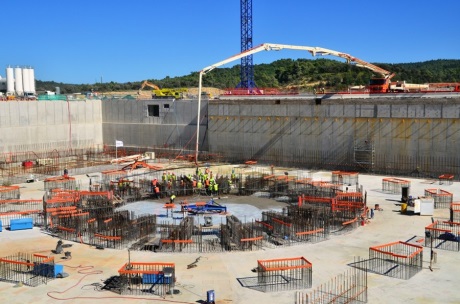Foundation in place for Iter Tokamak
28 August 2014
The concrete basemat has been completed for the Tokamak complex of the Iter fusion reactor project at Cadarache in southern France.
 |
| Pouring of the concrete for the central circular section marks the completion of the Tokamak complex slab (Image: Iter Organization) |
The 12-hour operation to pour concrete for the last of the 15 segments that make up the Tokamak complex basemat (the B2 slab) was completed at 6.00pm on 27 August. The pouring of concrete for the basemat started last December.
The B2 slab covers an area of 9600 square metres and comprises 14,000 cubic metres of concrete, 3600 tonnes of rebar and 2500 embedded plates. It will support some 400,000 tonnes of building and equipment, including the 23,000-tonne Iter Tokamak.
The slab is a 'floating' foundation: installed on seismic columns, it has a capacity for lateral movement of up to 10cm in any direction. A gap of some 1.5 metres separates the B2 slab from the surrounding retaining walls. The 1.5-metre thick slab will serve as the first basement level of the diagnostic, Tokamak and tritium buildings. Five large drain tanks, supports for the base of the cryostat, and the building walls will be positioned directly on it.
Completion of the Tokamak slab marks the conclusion of the preparatory phase of the construction site which started in August 2010 and represents an investment of some €100 million ($132 million).
Speaking to workers at the construction site, Iter director general Osamu Motojima said, "With the completion of the B2 slab, a new chapter opens in the history of our project. In September, construction of the Tokamak complex will begin in earnest. You have built the floor, now come the walls, then the roof, and after that the machine itself."
The Iter project is meant to take nuclear fusion research to a new level with the largest ever Tokamak unit, which should be capable of sustaining plasmas that produce 500 MWt for as long as seven minutes. The EU is funding half of the cost while the remainder comes in equal parts from six other partners: China, Japan, India, Russia, South Korea and the USA. The facility is expected to reach full operation in 2027.
Researched and written
by World Nuclear News